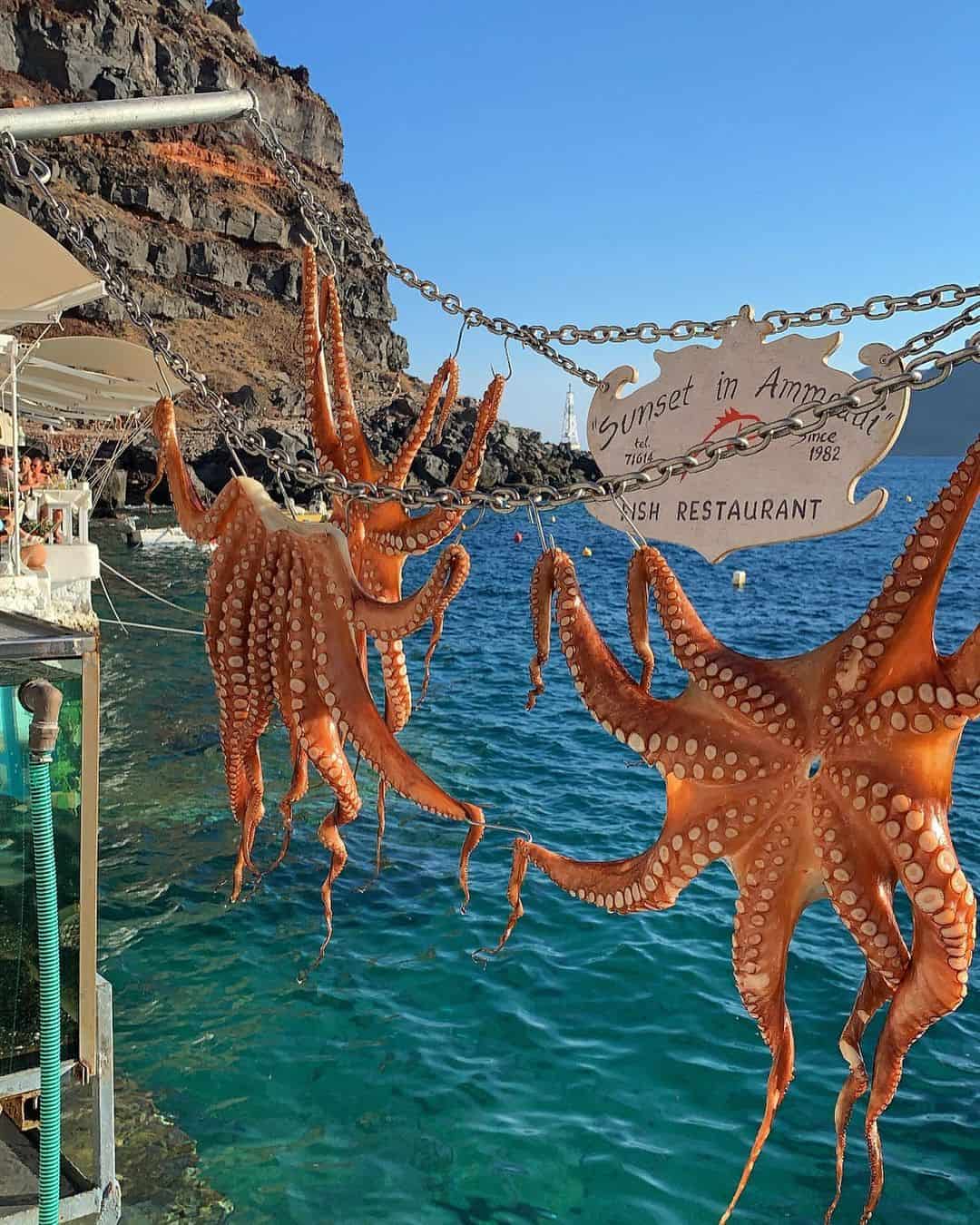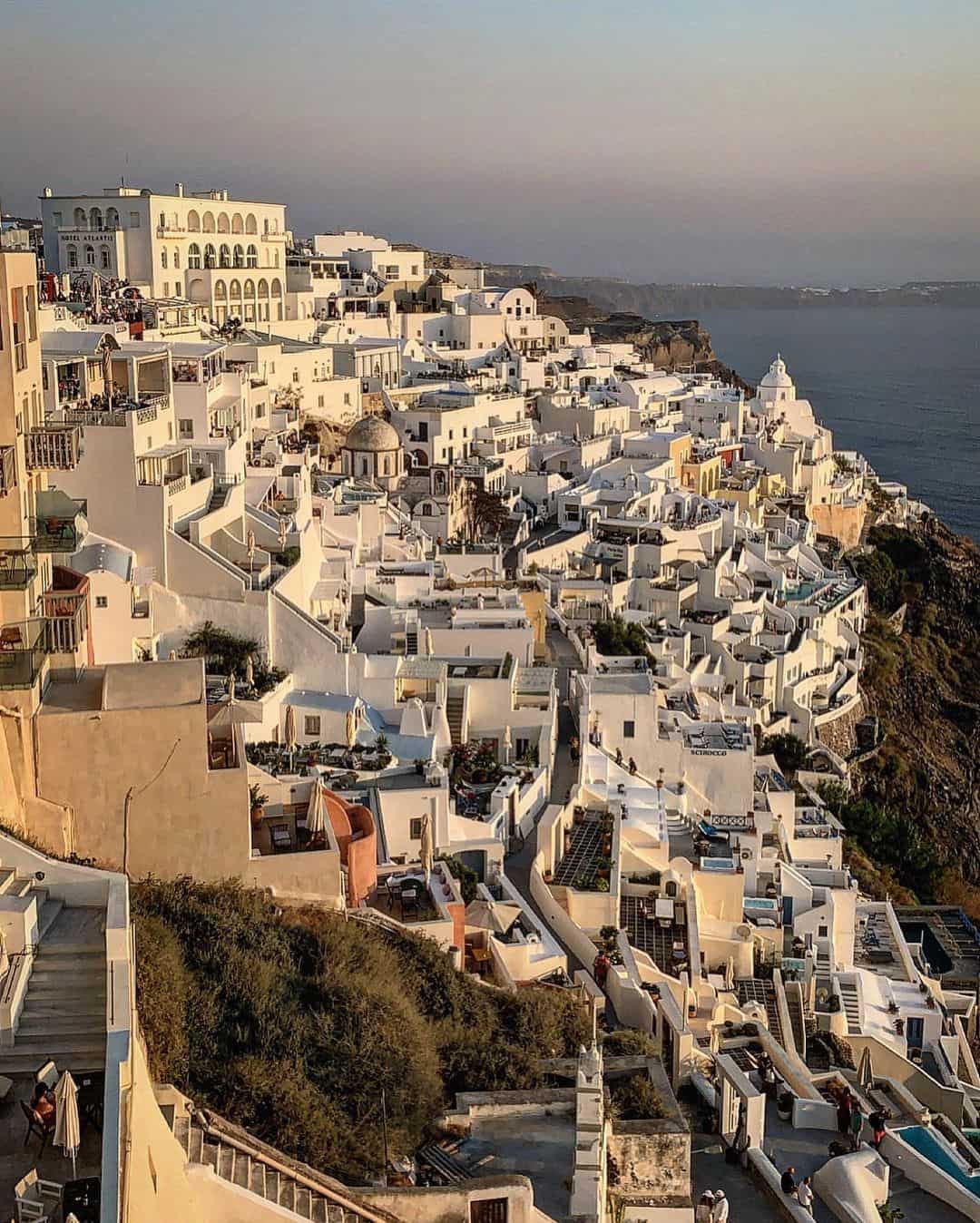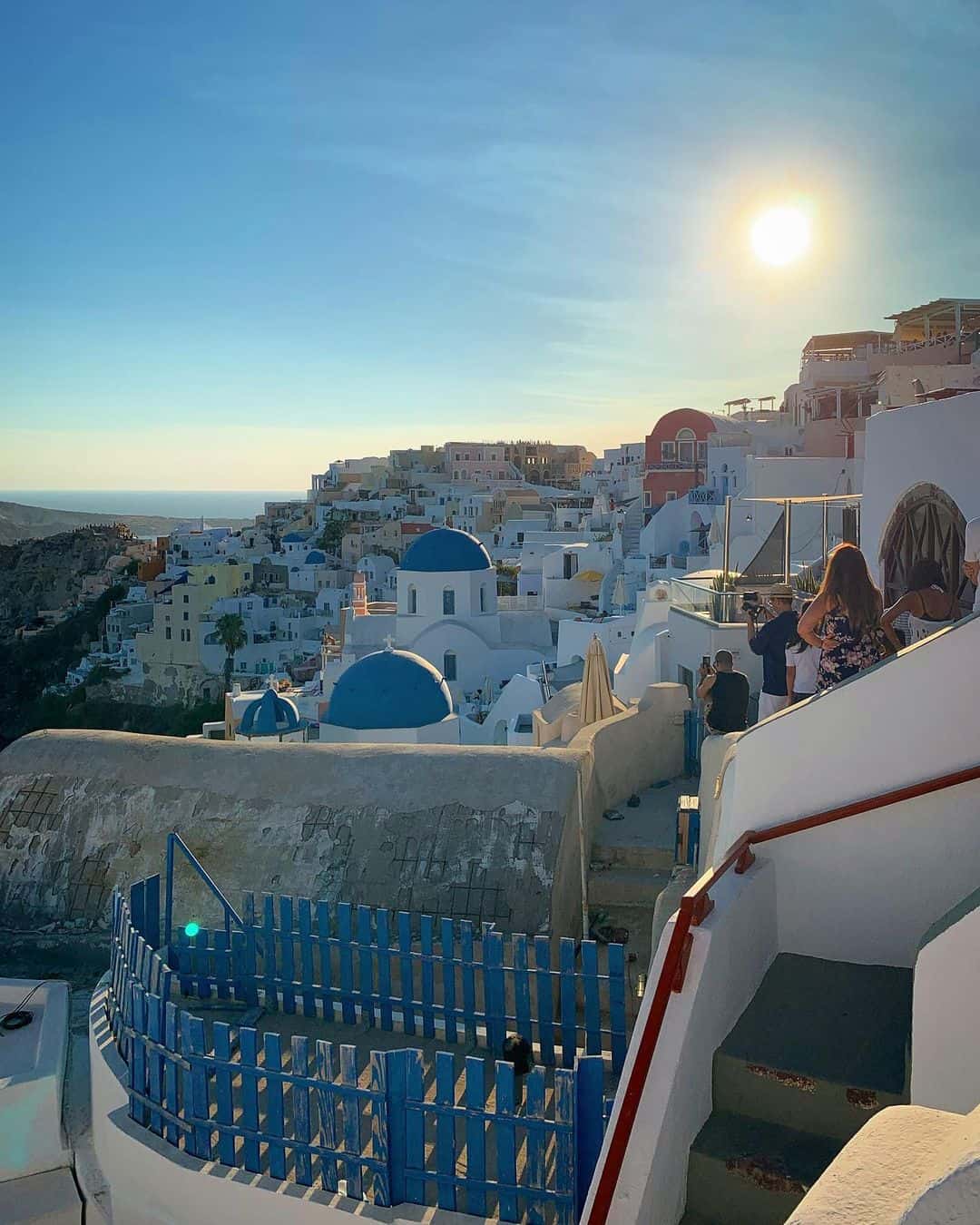24 Fascinating Facts About Santorini to Know Before You Go
Facts about Santorini? Most travelers may visit the famous Cyclades island in order to witness its breathtaking sunsets or stay in its ultra-luxe hotels.
Gorgeous Santorini is one of the best-loved travel destinations in Greece, and for good reason. Conquer the infamous Fira to Oia hike, have a fresh seafood lunch at Ammoudi Bay, and relax on the majestic beaches.
It is always useful to have a little background information about the places we visit. This helps us gain a deeper understanding and put what we see into more context. The facts about Santorini here may be things that you never knew, and yet, help you appreciate the island even more!
Facts About Santorini, Greece

Santorini is the only inhabited caldera in the world
Santorini is the world’s only inhabited caldera. Here, many of the cave houses and buildings actually sit atop volcanic soil.
The volcano here is presently dormant. However, it has erupted several times over the course of history and indeed, its eruptions are to thank for the island’s colorful sand beaches!
The last eruption of Santorini’s volcano was in 1950, and that was only minor. Is the Santorini volcano likely to erupt again?
Quite possibly. It is far from extinct. But as with all volcanoes, scientists monitor Santorini and it is currently dormant.
Santorini was previously known by another name
Santorini didn’t always go by the name of Santorini. This little island was previously known as Strogill, Kallisti, and Theras.
Each of these names has different meanings. “Strogill” means round, “Theras” means the son of a king, and “kallisti” means the most beautiful.
Latin inhabitants of the island changed its name in the 13th century to honor Saint Irene. Eventually, the name became Santorini.
Where is Santorini?
Where is Santorini? Santorini is situated in the south Aegean Sea, south of Athens and the Greek mainland.
It is part of the Cyclades archipelago, which is made up of approximately 220 islands. It is 200km south of Athens and it is relatively easy to get from Athens to Santorini (and vice versa). You can opt to do so via ferry from Piraeus or by plane.
What is the meaning of “Oia” and “Fira”?

Most Greek places/names are not “just” names. The vast majority have some kind of meaning in Greek.
A lot of Santorini locals believe that the name “Oia” means “far” in the Doric dialect. Similarly, “Fira” or “Thira” as it is often spelt, takes its name from the legend Thiras who colonised the island.
There are over 100 varieties of grapes on Santorini!
Santorini, like many Greek islands, dabbles in its own winemaking. There are more than 18 wineries scattered across the little island.
Nine of the 100 grape varieties found here are indigenous to Santorini, including the famous Assyrtiko. The island’s unique climate and rich, volcanic soil make Santorini one of the best wine regions in Greece.
A number of reputable companies offer Santorini wine tours. However, you can also organize tours and tastings with wineries and vineyards independently.
Santorini is the home of tomatokeftedes
Tomatokeftedes (tomato fritters) hail from Santorini and are featured on most Santorini menus. They are most commonly enjoyed as an appetizer or a meze dish to share.
You will find them across the Cyclades and elsewhere in Greece. But Santorini is the true home of the tomato fritter.
To create the dish, crushed tomatoes are combined with herbs, red onion, and feta cheese. They are then gently fried in olive oil.
You can recreate these at home, too and they are relatively simple to make. However, arguably the sweet, delicious tomatoes grown in Santorini’s volcanic soil are what make the tomatokeftedes here so unique.
Fava bean puree hails from here too
Fava bean puree also hails from the island of Santorini. This yellow dip is a favorite starter/meze across Greece but it originated here, where the fava beans are grown.
The fava beans are pureed and cooked with fresh garlic, thyme, and onions. A drizzle of lemon juice and olive oil and a scattering of capers are usually added to the top of the fava. This is typically then served with crusty bread for dipping.
Several movies have been filmed here

Gorgeous Santorini has acted as the filming location for a number of Hollywood movies. These include movies about Greece and general action movies.
Movies about Greece that have been shot here include Santorini Blue (2013) and Summer Lovers (1982). Chick Flick The Sisterhood of the Travelling Pants (2005), and the original 2003 Tomb Raider starring Angelina Jolie.
Different civilisations have ruled Santorini over the centuries
Santorini, like much of Greece and Southern Europe, has passed through the hands of different rulers and civilisations over the centuries. Each has left its mark on the island’s culture, cuisine, and architecture.
The Venetians and the Byzantines ruled Santorini for centuries. That is until the Ottoman Turks took over. Greece finally gained its independence from Turkey in 1821.
Many Santorini beaches have colored sand
Santorini is generally not known for its beaches. When people are choosing whether to travel to Santorini or Mykonos, they will often opt for the latter because its beaches are better.
However, that is not to say that Santorini is not home to some beautiful coastal areas! A lot of the beaches here have colored sand.
They are quite unlike anything else you will likely have seen elsewhere. Why do they look like this?
The colored beaches are due to the volcanic nature of the island. Past eruptions have not only shaped the geographical landscape of Santorini, but they have also caused colourful volcanic rock to disintegrate into colored sand.
The Red beach is perhaps the prettiest and most famous of all of Santorini’s beaches. It is just a short distance away from the archaeological site of Akrotiri and is characterised by its red cliffs and rocks.
Some of Santorini’s beaches also boast black sands. For instance, Perivolos beach, Perissa, and Agios Georgios.
These three beaches are in the southwest of the island. They are all just a short walk from each other.
There are 450 churches on the island
Greece is a deeply spiritual country with strong roots in the Orthodox faith. On Santorini island alone, there are more than 450 churches in all different shapes and sizes.
Some exude grandeur and elegance. Others are hidden away from view in the heart of the woodlands and not marked on any map.
Several great books have been written about the island
Reading books about Greece is a nice way to prepare for your trip to the Mediterranean. ¨Since I don’t have you¨ is a heartwarming fiction book about a woman who moves to Santorini after experiencing a tragedy.
It is a nice thing to read to get you in the mood while planning a trip to Greece or while sitting by the pool on vacation. If you are looking for non-fiction books about Santorini, there are plenty of those too.
Santorini: Portrait of a Vanished Era is a collection of photographs, reflections, and musings by Robert McCabe and Margarita Pournara. It portrays a very different Santorini: the Santorini of the 1950s before the tourists arrived.
Santorini boasts some of the best sunsets in Greece
Saying that Santorini is home to some of the best sunsets in Greece may be more subjective than being one of the facts about Santorini you should know. However, ask any Greek or tourist the best place to see the sunset in the country and they will tell you the same thing: Santorini.
There are plenty of excellent places to see the sunset so that you can enjoy different viewpoints too. For instance, if you opt to take a boat cruise, you can get a unique view of the island from the water.
Alternatively, hiking up to the Akrotiri Lighthouse offers you a breathtaking panorama over the Cyclades. Ammoudi Bay is another nice spot. So too is the hilltop village of Imerovigli.
Several famous Greeks hail from here
Perhaps one of the most interesting facts about Santorini, particularly if you are of Greek descent, is that several well-known Greeks hail from here. Former Prime Minister Spyros Markezinis was from Santorini.
Famed composer Yiannis Chryssomalis and business mogul Giannis Alafouzos were also born and raised here.
There is an interesting reason the buildings are blue and white
Buildings painted in blue and white have become the symbol of Greece and the Cyclades. Any mention of Greece conjures up images of meandering down little cobbled streets past whitewashed buildings with blue domed roofs.
But why do buildings in this part of the world look like this? The reason is actually relatively dark and obscure.
A cholera outbreak in 1938 led people to start painting their homes white. For years, Greece was a dictatorship and during that time, it was decided that people must make their homes white AND blue to represent the Greek flag.
Santorini boasts several hiking trails
People don’t always associate Greece with hiking. But why would a country with such natural beauty not be a good place to go walking and trekking?
The Fira to Oia hike in Santorini is perhaps the most famous walking route. You can opt to hike all or part of it.
If you opt to do the hike in full, you will walk approximately 6 miles. Along the way, you will pass through quaint villages, past vineyards, and through ethereal landscapes that almost look otherworldly.
But the Fira to Oia hike is not the only hiking trail on the island. The route from Pyrgos to Prophet Elias Monastery is rewarding.
So too, is the trek from Megalochori to the Thermal Baths of Plaka. The only thing to consider?
Greece gets very hot during the summer months. So, you are best to try these hikes very early in the morning or travel during the offseason.
The island has been inhabited for thousands of years
It is believed that Santorini has been inhabited since the neolithic period. In other words, humans have lived here since approximately 10,000–4,500 BC!
The island hosted an important civilization around 3600 BC. Excavation work done around the island indicates that a very important Minoan settlement existed near Akrotiri.
There was a terrible earthquake in 1956
There is a lot of seismic activity across Greece and Santorini is no different. In 1956, a large earthquake in nearby Amorgos rocked the two islands and caused significant damage.
This was the largest earthquake in Greece in the 20th century. Since then, there have been a couple of minor earthquakes but nothing that has caused substantial or lasting damage.
There was an earthquake with a magnitude of 4.2 on the Richter scale on the 13th of January 2019. Then, there was another with a magnitude of 4.1 on the 26th of April 2020.
The Minoan eruption was one of the largest volcanic eruptions in history
The Santorini volcano has erupted a number of times throughout history. However, no eruption was larger or more damaging than the Minoan eruption in around 1613 BC.
This was one of the largest Plinian eruptions on earth in the past 10,000 years. In fact, it was so large that it is believed to have destroyed the majority of the island, completely changing its shape.
This was the second-largest volcanic eruption in human history. It is second only to the eruption of Mount Tambora in Indonesia in 1815.
Akrotiri is essentially Greece’s Pompeii
The archeological site of Akrotiri, Santorini is one of the most important historic sites in the Aegean. It could be compared to Italy’s Pompeii, as the entire settlement was buried under dust and debris following a volcanic eruption.
It was home to the Minoans for more than 4000 years and is well preserved to look almost as it would have appeared in 1500 BC. Akrotiri was initially a humble farming village before its strategic location by the sea transformed it into an important and prosperous port city.
Santorini may be the lost city of Atlantis
There is an ongoing debate and discussion as to whether Santorini is the lost city of Atlantis. Greek Philosopher Plato mentioned the great civilisation of Atlantis in his musings.
He later states that Atlantis suffered a terrible earthquake and a flood, causing it to completely sink into the ocean. But was mythical Atlantis a real place?
It appears that Plato uses Atlantis as an analogy to illustrate a point about the dangers of aggressive imperialism. But the metaphor was lost on some who have been searching for the lost, advanced continent for thousands of years.
Excavations at Akrotiri suggest that Santorini could well be the Atlantis we hear about. At least in terms of Plato’s own musings. However, even so, there are also those that argue that Atlantis was based on Minoan civilisations in Crete.
How big is Santorini?
Santorini has a population of 15,500 and an area of 76 square miles. You can drive from one side of the island to another in around 45 minutes.
There are approximately 13,500 permanent residents on the island. However, approximately two million people visit the island every year, causing the population to swell significantly during the Greek summer months.
The island did not have electricity until 1960
Today, Santorini is synonymous with luxury hotels, infinity pools, and upscale bars and restaurants. Tourism has caused the island to accelerate its growth and development.
However, prior to 1960, there was no electricity on the island. Most people worked in humble professions (e.g.) fishermen. They got around by donkeys and mules – much like on the Greek island of Hydra today.
Santorini boasts relaxing hot springs
One of the perks of Santorini being a volcanic island is that the island is home to natural thermal hot springs. What could be a better way to indulge in some R&R on your Greek island hopping vacation?
The underground volcanic activity means that the water maintains a constant temperature between 30 and 35 degrees Celsius. The springs can be found on the tiny, uninhabited islet of Palea Kameni.
They get very crowded during the busy summer months so it is worthwhile considering travelling out of season. Spring and Autumn in Greece are very pleasant times to visit. Temperatures are warm but not unbearable, and the prices and crowds are significantly reduced.
